


MAURIZIO GALIMBERTI
Ambra Angiolini

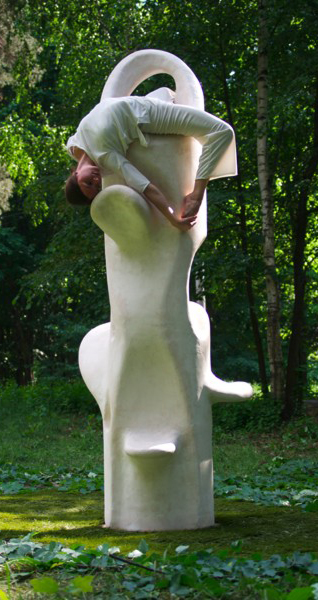
Eve Bailey
ИВ БЭЙЛИ
ENTASIS DANCE IV
My work is based on the concepts of balance and coordination. The body interests me as a perceiving mechanical structure. I use my own body as a primary tool to create pieces that experiment with equilibrium through physical, mechanical, plastic and conceptual means. My studio practice is rooted in the tradition of the artist engineer. I design and build suspended and pendular constructions that can sustain their own weight and mine as I perform with them. By climbing and inverting on the structures, I challenge my own perception and creative process.

DI MAINSTONE AND TIM MURRAY-BROWNE
Serendiptichord
The result of a cross-disciplinary investigation spanning fashion, technology, music and dance, the Serendiptichord is a wearable musical instrument that invites the user (or movician) to explore a soundscape through touch and movement. This curious device is housed in a bespoke box and viewed as part of a performance. Unpacked and explored on and around the body, the Serendiptichord only reveals its full potential through the intrepid curiosity of its wearer. Adhering to the body like an extended limb, this instrument is best described as choreophonic prosthetic. Referencing the architectural silhouette of a musical instrument and the soft fabrication of fashion and upholstery, it is designed to entice the movician to explore its surface through touch, physical manipulation and expressive movement. Although this acoustic device can be mastered alone, it also holds subtle openings for group interaction.

Stelarc
StickMan
StickMan is a minimal but full-body exoskeleton that algorithmically actuates the artist with 6 degrees-of-freedom. It is a gesture generating system capable of 64 possible combinations. Sensors on StickMan generate sounds that augment the pneumatic noise and register the limb movements. A ring of 6 speakers directs and circulates the sounds.

Chloé Moglia
Horizon
O limbo está no centro da arte de Chloé Moglia. Seja como integrante da Compagnie Rhizome, solo ou em produções conjuntas, a artista está sempre preocupada com a leveza. Em suas performances, que combinam força física e poesia, ela derrota as leis da gravidade e o medo das alturas. Além disso, ocorrem reflexões sobre o tempo, principalmente pela lentidão de seus movimentos. Chloé Moglia transita entre a disposição de arriscar e a busca de sentido e empolga o público ao brincar com o medo da queda. A performance de Chloé Moglia aqui apresentada intitula-se Horizon. O nome desta obra-prima física, criada em 2013 por encomenda do Festival Paris Quartier d’Été, foi escolhido de forma excelente. Horizon é um jogo entre o trapézio e uma estrutura esguia que serve tanto como elemento escultural quanto como elemento de sustentação. Nesta constelação, Moglia cria um espetáculo leve que se encaixa perfeitamente em seu entorno.

Lars Spuybroek
Oblique WTC
.
著者によると、この建物は単一の巨大構造を形成しており、複雑なネットワークを形成しており、個別のコンポーネントに分解することはできません。 この質感は、ウールニットと比較されます。 中には公共のスペースを含むいくつかのスペースがあります。 通りは曲がった塔に合流しているように見え、その中のエレベーターは坂を上って街の地下鉄に降りる列車になります。
.
Здание, по мысли автора, образует единую мегаструктуру, сложную сеть, не раскладывающуюся на отдельные компоненты. Эта структура сравнивается с шерстяной вязкой. Внутри располагаются различные пространства, в том числе и общественные. Улицы как бы вливаются в гнущиеся башни, а лифты внутри них становятся поездами, взбирающимися по наклонным плоскостям и спускающимися в городской метрополитен
.
The building, according to the author, forms a single megastructure, a complex network that cannot be decomposed into separate components. This texture is compared to a wool knit. Inside there are various spaces, including public ones. The streets seem to merge into bending towers, and the elevators inside them become trains that climb inclined planes and descend into the city subway.

PEEPING TOM
32 rue vandenbranden
The script of physical actions is inspired by the Japanese film A ballad de Naraiama (1983), by Shohei Imamura, the one with tearing images, like that of the son carrying his mother on his back, embraced by the wind, climbing the mountain to put her on the summit until death, as the local tradition says that every septuagenarian must have an equal destiny. In the same village in the late 19th century, parents used to sell babies to survive. These material and spiritual miseries do not bring literals to the stage. Rather, they are essentials that make the show a fabulous visual poem written in and with the body and the scenic space. The song is also celebrated at the height, with moments such as Stravinski’s The Bird of Fire suite, and the song Fline on you crazy diamond, by the band Pink Floyd.

BANDALOOP
100 Northern Ave
You’ve probably never seen anything like this before. Six members of the vertical dance troupe BANDALOOP descended the façade of the new 100 Northern Ave. building commemorating its grand opening at Boston’s Seaport District. The performers are held securely by special rigging allowing them to mesmerize audiences with dynamic physicality and intricate choreography. BANDALOOP honors nature, community, and the human spirit through perspective-bending dance. A pioneer in vertical performance, BANDALOOP seamlessly weaves dynamic physicality, intricate choreography and climbing technology to turn the dance floor on its side. Under the artistic direction of Amelia Rudolph, the work re-imagines dance, activates public spaces, and inspires wonder and imagination in audiences around the world.

AURÉLIEN BORY
PLEXUS
Aurélien Bory is a Toulouse-based choreographer working at the intersection of dance, circus and visual art. In Plexus, he encloses the Japanese dancer Kaori Ito in a forest of tensioned vertical cables. It’s as if she’s in a transparent cuboid cage. We can see her, but her image is blurred by the shimmer of Arno Veyrat’s lighting as it moves across the cables. Ito strains against these confines, writhing, flailing and hurling herself against the cables. Every sound is hugely amplified, so with her every movement we are assailed by a high-tensile jangling and groaning. At intervals she subjects her environment to furious challenge, racing backwards and forwards within the limited inner space so that the cage rocks on its axis. At other times she positions herself between the cables so that they bear her weight, and hangs there like an exhausted insect, faintly articulating her limbs.

EVA PAPAMARGARITI
Liminal Beings
Liminal Beings explores the concept of automaton and the different anthropomorphic forms and functions embedded within its ontology. Automata, since ancient times, have been standing on the verge of two states, developing machinic and human characteristics simultaneously – in reality, and in the collective consciousness. They are trained to execute and learn respective actions and procedures, thus creating an uncanny, awkward state, trapped in limbo between diverse conditions of existence.
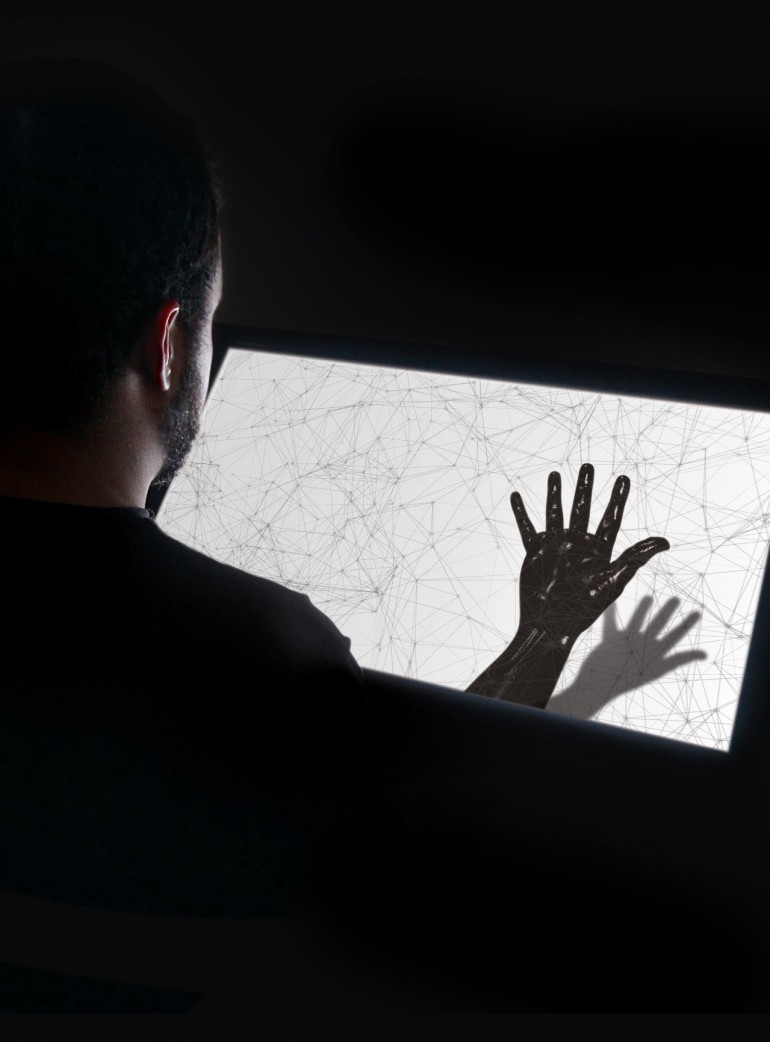
Índice
Jonattas Poltronieri, Luis Mello, Pedro Venetucci & Rofli Sanches
Phantom Limb
Just like the original box, the installation is a rectangular unit where the user inserts his arm and is urged to move it in different ways. The similarity with the original object disappears as, instead of having a mirror to provide the image that motivates the interaction, there is a screen that mediates the user’s view and the place where his arm actually is. The displayed image of the user’s arm can be reversed, distorted and coloured, among several modifications to simulate in a rich way the strangeness of not having control over a member, and to question whether what is seen is an accurate portrayal of the real body. Although deep and subjective, the topic addressed in this experience is easy and accessible in its interaction, offering various sensory feedbacks to the user. Through it, it is proposed that we experience and reflect upon the disconnection between thought and body, intention and action, sensation and reality.
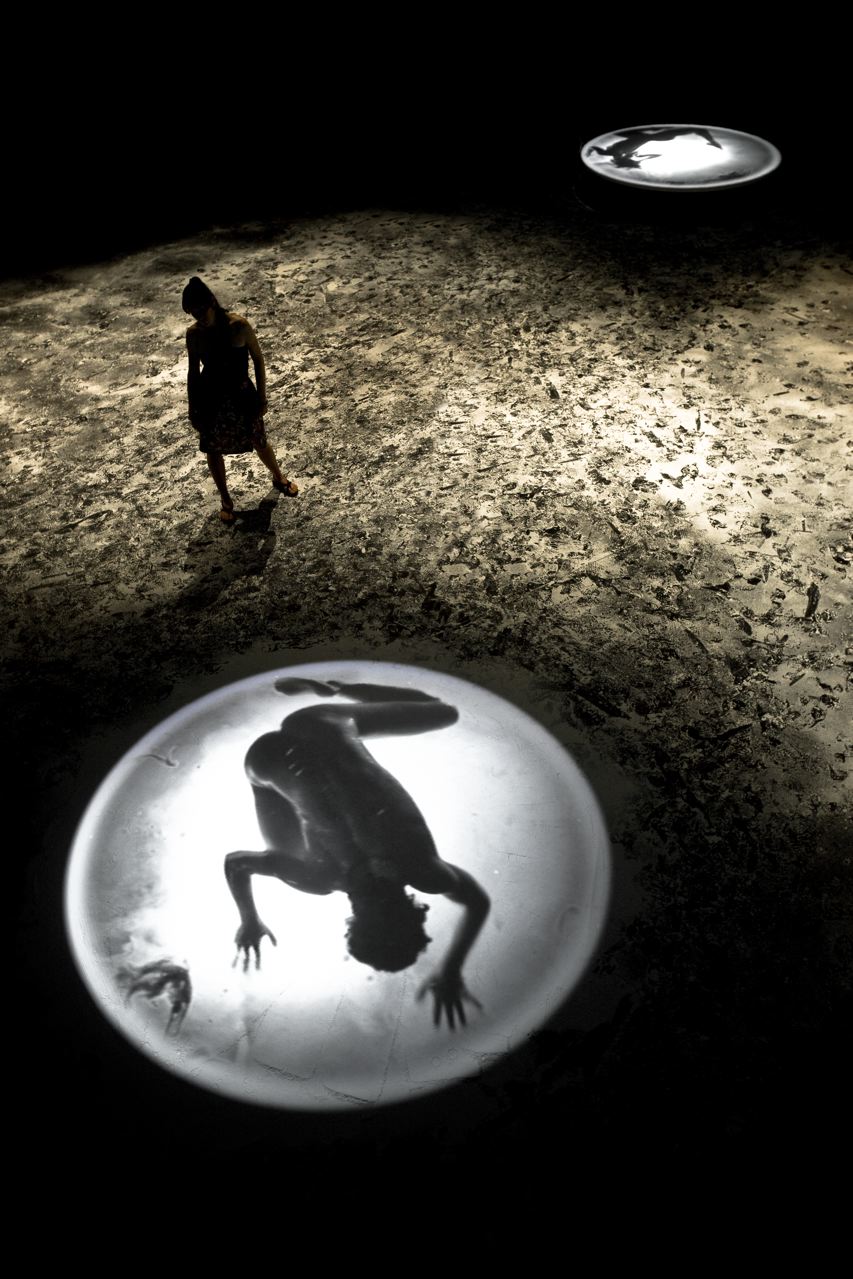
KEITH ARMSTRONG
Shifting Intimacies
An interactive/media artwork for one person at a time. Each participant enters a large, dark space containing two circles of projected film imagery presented within an immersive sound environment. One image floats upon a disc of white sand and the other on a circle of white dust. Participants’ movements direct and affect the filmic image and spatialised audio experience. Throughout the work a layer of dust (an artificial life form) slowly eats away and infuses itself deep into the imagery and sound. Each person has 10 minutes alone with the work. Their movement through the space continually affects speed, quality, balance and flow within the work. At the end of the experience they are invited to climb a lit platform and cast dust back onto the images below.
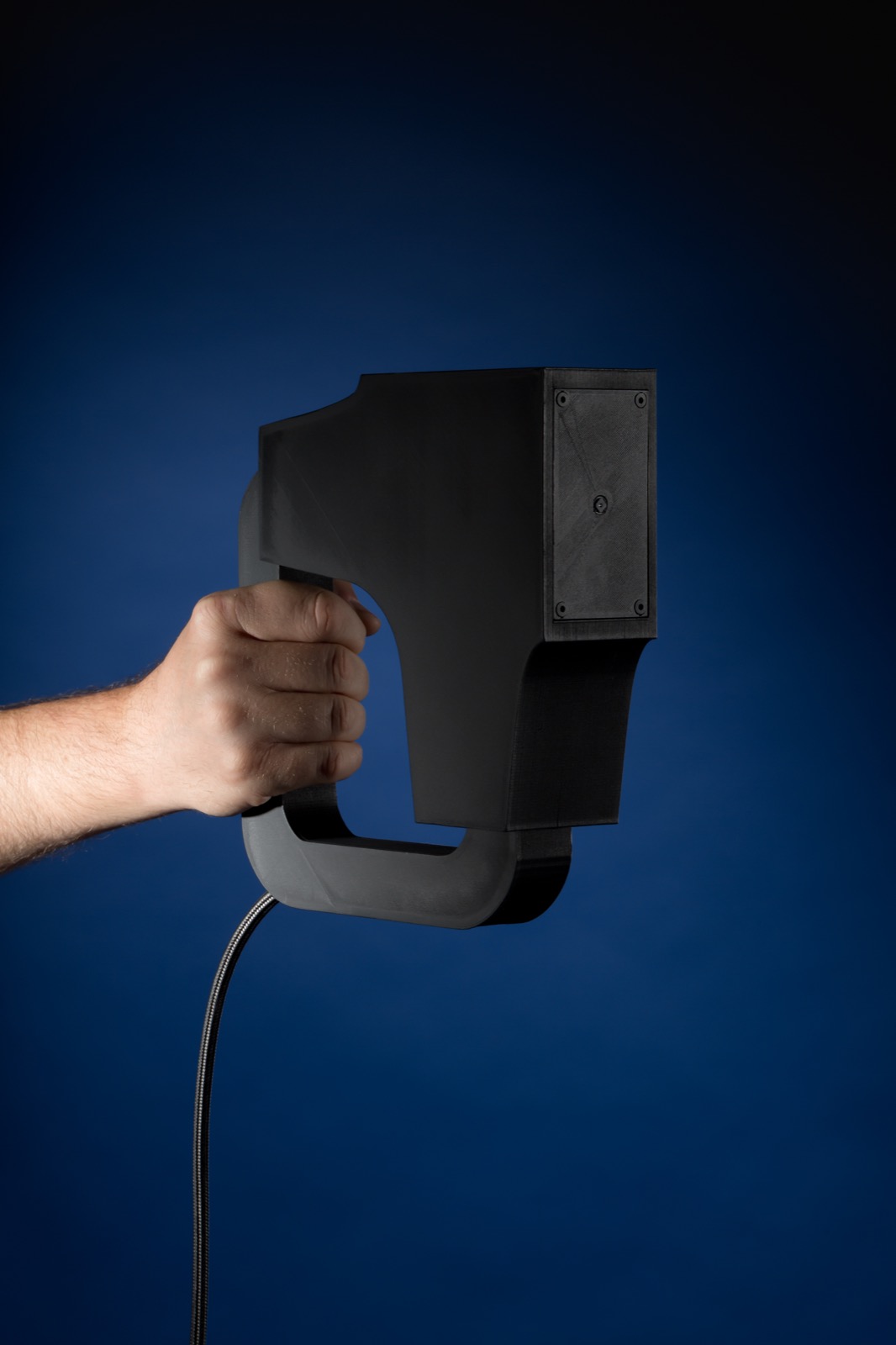
Marta Revuelta
AI Facial Profiling, Levels of Paranoia

PLAYDEAD
Limbo
Arnt Jensen
File Festival
FILE GAMES
Limbo is a 2D sidescroller, incorporating the physics system Box2D to govern environmental objects and the player character. The player guides an unnamed boy through dangerous environments and traps as he searches for his sister. The developer built the game’s puzzles expecting the player to fail before finding the correct solution. Playdead called the style of play “trial and death“, and used gruesome imagery for the boy’s deaths to steer the player from unworkable solutions.
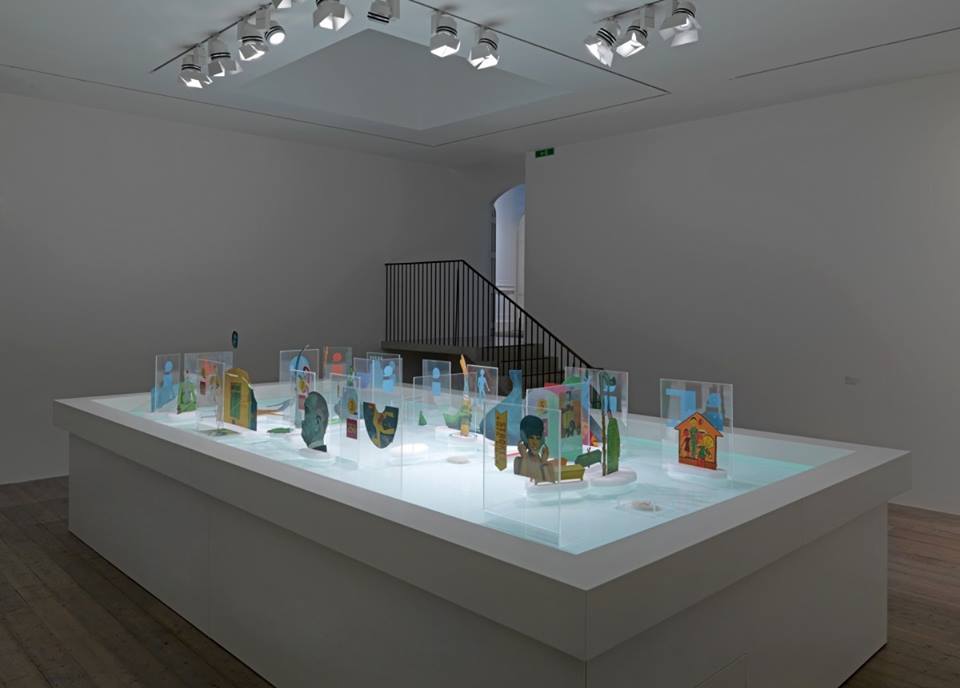
ÖYVIND FAHLSTRÖM
The Little General Pinball Machine
“One of the most memorable pieces in the 1997 Documenta X was Öyvind Fahlström’s The Little General (Pinball Machine), 1967. Resembling a raised indoor swimming pool with some two dozen movable parts spread out across its shimmering Plexiglas surface, the thirty-year-old “variable” sculpture radiated a visual audacity that made much of the current work around it pale by comparison. Ersatz scoring cues brushed up against cutouts of historical and pop-culture figures, who in turn seemed to jostle dismembered cartoon limbs and partial anatomies. The cumulative effect was dizzying, as if news, commercials, and cartoons were being broadcast in one overpowering barrage.”Dan Cameron

SOU FUJIMOTO ARCHITECTS
على فوجيموتو
후지모토에
על פוג’ימוטו
НА ФУДЗИМОТО
infinity ring pavilion
An investigation into the ergonomics of seating in both private and public environments, the Infinity Ring takes the preconception of predefined spaces and their rituals and wraps it around a ring, creating a continuous strip of inhabitable spaces. The entire ring is then rotated, thereby generating infinite configurations of space-between-space, creating endless ways to sit, climb, lie down, crawl on…resulting in spatial configurations that are much richer than the sum of its parts.

Lin Hwai-min
Formosa
“Formosa relies heavily on words and poetry for its inspiration and imagery. It traces Taiwan’s history from the 16th century, when Portuguese sailors upon seeing the island exclaimed, “Formosa!” meaning “Beautiful!” Poems appear on a white scrim above a white floor. In the beginning, the poems are whole. The black Chinese characters are neatly aligned. Gradually, however, the poems slide away and the characters enlarge, slowly disappear, become abstract, pour like a stream, peel away, and break apart. A chaotic jumble appears. To some extent, the writing dances.” Carmel Morgan
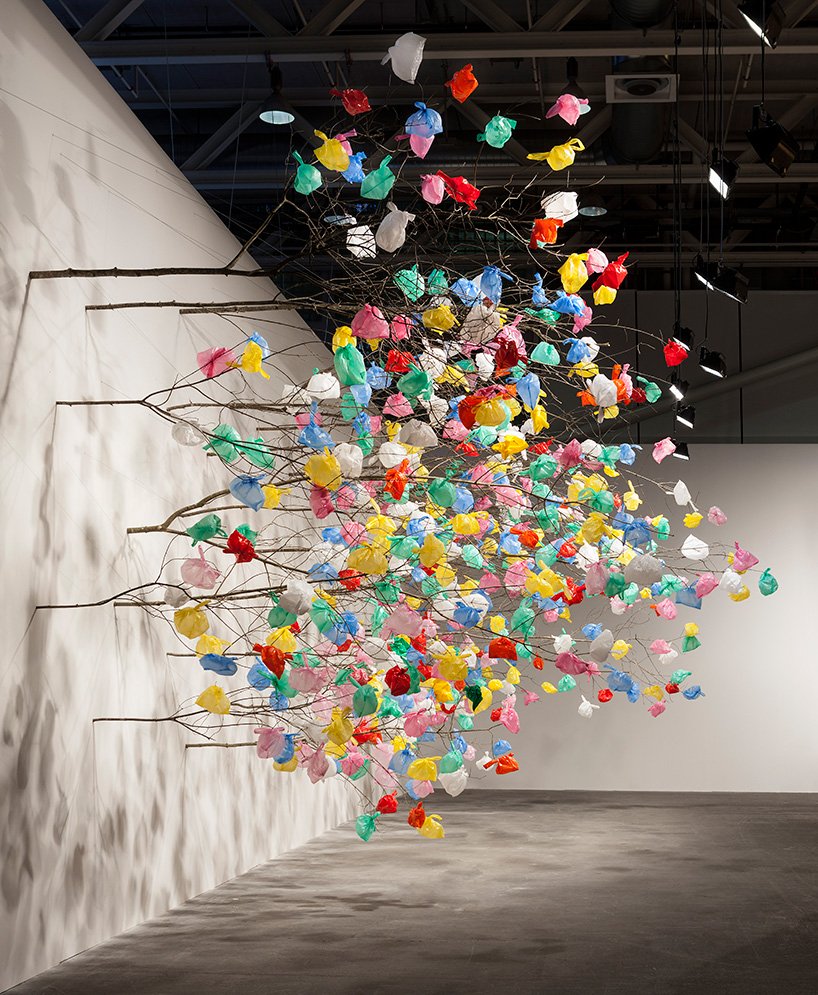
Pascale Marthine Tayou
Plastic tree
Tree branches of various distances and dimensions grow horizontally from the surface, inverting the usual experience and traditional relationship we have with trees. rather than leaves, the bark bears brightly colored plastic bags on its edges, crudely tied to each organic limb. While the work stands as a visual symbol of the harmful effects of pollution and consumerism on the environment, ‘plastic tree’ is also an investigation towards the artistic qualities of plastic as a medium, and its incorporation with natural materials.

Genesis Belanger
Acquiesce
Genesis Belanger twists and stretches familiar objects into surreal scenarios with her stoneware, porcelain, and concrete sculptures. The Brooklyn-based artist frequently depicts detached limbs, misplaced teeth, and unusually located food in her work. One sculpture shows a mustard-topped hot dog disappearing into a handbag with a mouth-like zipper; another series dispenses rocks from dysfunctional quarter candy machines. This spring, a stoneware desk topped with flaccid pens, a tape-like tongue dispenser, and a drawer full of coping mechanisms was on view in the New Museum’s store window gallery.

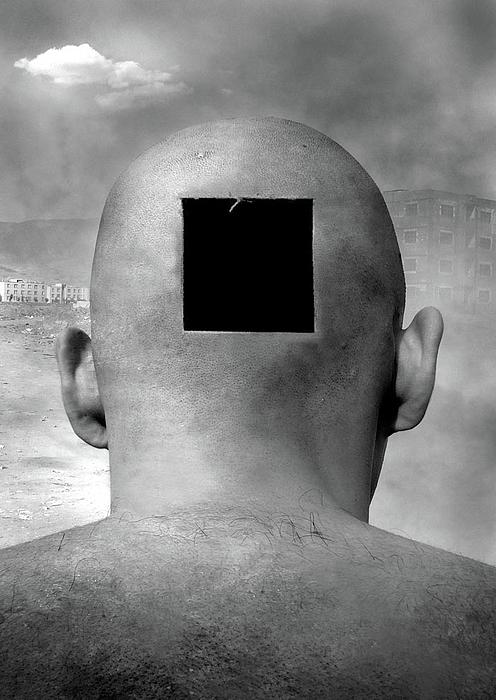
SAMAD GHORBANZADEH
Gray Nightmares
Grey Nightmares” is the name of a personal collection in which different subjects have been studied, the ones I have been involved in for the last couple of years. The subjects include, loneliness, death, nihility, downfall, pain, wait … though the main characters of this collection are the people who are looking for a way out of their limbo so that it can be a relief for them.

MOTOHIKO ODANI
元彦小谷美纱
小谷元彦
Мотохико Одани
Phantom Limb
Motohiko Odani est un artiste japonais vivant à Tokyo où il expose régulièrement ses oeuvres. Multi disciplinaire, ce créatif s’exprime aussi bien en sculpture, photographie ou vidéo, où il traite de la mutation des hommes et des animaux. Ses sculptures, à la fois étranges et fascinantes, s’inspirent de mondes fantastiques et ne peuvent laisser indifférent.
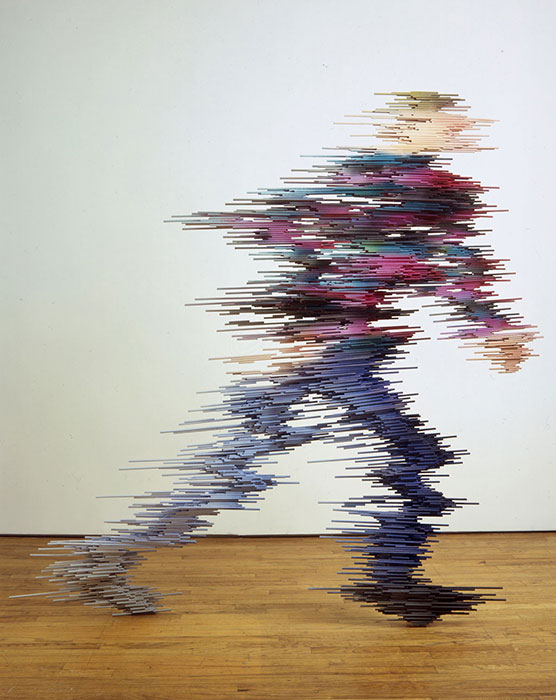
RYAN JOHNSON
Райана Джонсона
pedestrian
Ryan Johnson’s pieces made from found and repurposed materials are very much rooted in traditional figurative sculpture, but he has abstracted the forms, making his work have a weird gestural quality. The drawing and writing he does on the casting tape he uses plays on the idea that it’s usually wrapped around broken limbs, but it also allows him to use it to create another thread of communication within his work. His ‘Pedestrian’ series of figures made out of wood and paint is also really stunning – they look like people zapping between dimensions.

JI WENYU AND ZHU WEIBING
计文于-朱卫兵
Up the Mountain/Down the Mountain
Soft installation is artistic language adopted by JI Wenyu and ZHU Weibing who employ fabric like cloth, silk and cotton for countless changes and possibilities. Seemingly gentile and nonaggressive, however, material of these types equips the artists with unique power. Their works cover themes like social structure and humanity and all sorts of statuses. It took them three years to complete Climbing up the Mountain, Climbing down the Mountain. Composed of 888 figures climbing up and down the mountains respectively.

PAOLA GAETANO-ADI
Desiring Machine: and/or the female reincarnation of Sisyphus
Née en Argentine, Paula Gaetano Adi est artiste et chercheure dans les domaines de la sculpture, de la performance, et des installations interactives et robotiques. Elle utilise le corps humain et non humain comme point de départ de ses recherches, et s’intéresse aux effets discursifs et aux impacts affectifs des technosciences sur la subjectivité humaine et dans l’art. Ses œuvres ont été présentées sur la scène internationale à Beijing, Berlin, Madrid, Moscou, Stockholm, São Paulo, New York, Poznan et Buenos Aires, entre autres. Elle a reçu de nombreux prix et bourses, tels que le premier prix à la compétition VIDA 9.0 sur l’art et la vie artificielle, organisée par la Fundación Telefónica, et le premier prix LIMbØ du Musée d’art moderne de Buenos Aires, la bourse Fergus Memorial en 2009 et 2010 de même que la bourse accordée à un artiste ibéro-américain dans le cadre de la compétition VIDA 14.0. À l’heure actuelle, Paula Gaetano Adi est professeure adjointe dans le programme de Studio Art du College of Visual Arts and Design de l’Université de North Texas, où elle coordonne le secteur réservé aux nouveaux médias. À cette université, elle s’est également jointe au groupe Initiative for Advanced Research in Technology and the Arts (iARTA).


Eve Bailey
ИВ БЭЙЛИ
Tongue in Cheek
My work is based on the concepts of balance and coordination. The body interests me as a perceiving mechanical structure. I use my own body as a primary tool to create pieces that experiment with equilibrium through physical, mechanical, plastic and conceptual means. My studio practice is rooted in the tradition of the artist engineer. I design and build suspended and pendular constructions that can sustain their own weight and mine as I perform with them. By climbing and inverting on the structures, I challenge my own perception and creative process.
With the combination of the two mediums sculpture and performance, I seek balance in the mind versus body relationship. My work alternates between theory and practice. The intellect occurs in the engineering of my structures and the sensuality arises from my body in motion, bringing together two talents commonly thought as disparate: male versus female, rational versus instinctive. All my pieces are created upon contrastive ideas and principles. I constantly play with contradictions whether they are of visual, physical or conceptual nature.
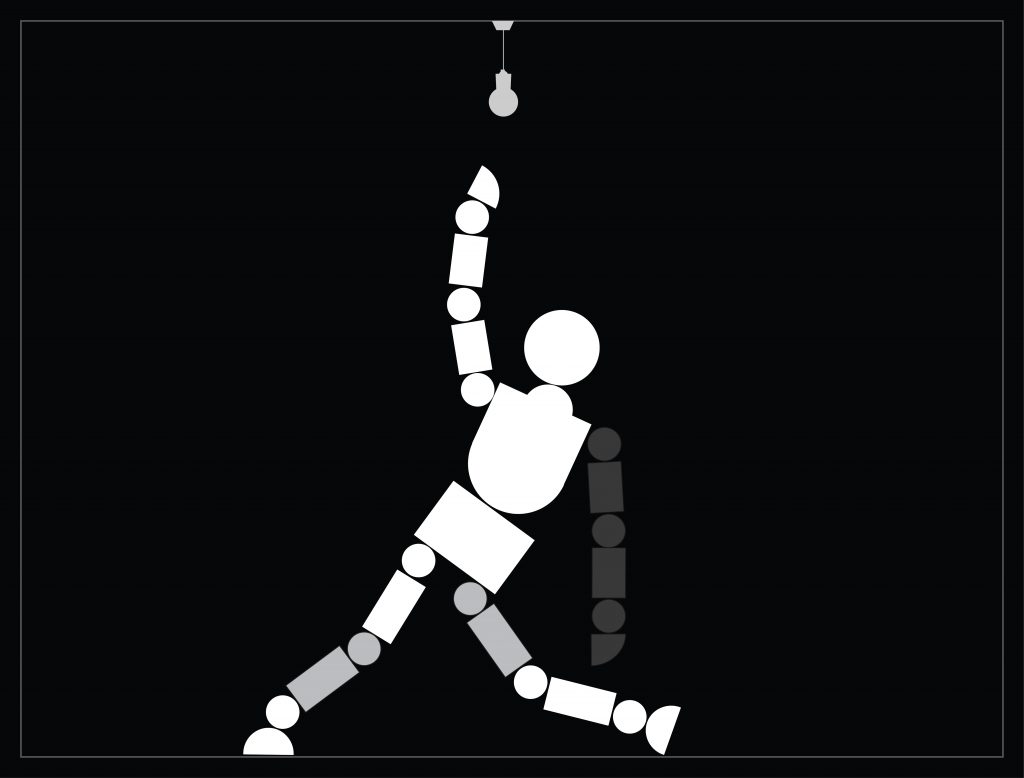
ANDREW HIERONYMI
Digits
File Festival
“Digits” is a single player wall projection installation game using a multi-touch tablet (iPad) as a controller. The game consists of moving a puppet using a set of dials.
The player can manipulate the dials on the tablet by performing a rotational gesture with the finger, which will rotate the joints of the puppet on the wall projection. Multiple dials can be rotated at the same time.
If the player lifts his fingers from the touch screen, the joints and limbs of the puppet will gradually fade and loosen his articulations. Because the puppet is subject to gravity, the player has to time the joint rotations in order to coordinate the movements of the puppet.

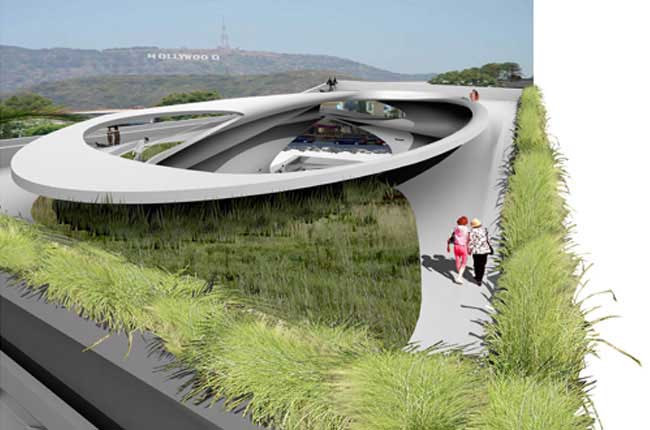
MARGARET GRIFFIN
Schindler’s Paradox Box
The double helix ramps descend towards the new open auditorium and climb 15 meters until they reach an open roof garden that offers interesting views from below, from above and the border between them. Helical lines are connected on the north side of the house to reconnect on the roof and at the level of the underground auditorium. The interlocking ramps create a continuous common surface that flows between them, emphasizing views of the property, Kings Road and adjoining apartment buildings. The support surfaces of the ramps are independent of the Berlin walls that support them.

DILLER + SCOFIDIO
The Blur Building (an architecture of atmosphere)
The Blur Building is a media pavilion for Swiss EXPO 2002 at the base of Lake Neuchatel in Yverdon-les-Bains, Switzerland.From piles in the water, a tensegrity system of rectilinear struts and diagonal rods cantilevers out over the lake. Ramps and walkways weave through the tensegrity system, some of them providing a counterweight for the structure. The form is based on the work of Buckminster Fuller.The pavilion is made of filtered lake water shot as a fine mist through 13,000 fog nozzles creating an artificial cloud that measures 300 feet wide by 200 feet deep by 65 feet high. A built-in weather station controls fog output in response to shifting climatic conditions such as temperature, humidity, wind direction, and wind speed.The public can approach Blur via a ramped bridge. The 400 foot long ramp deposits visitors at the center of the fog mass onto a large open-air platform where movement is unregulated. Visual and acoustical references are erased along the journey toward the fog leaving only an optical “white-out” and the “white-noise” of pulsing water nozzles. Prior to entering the cloud, each visitor responds to a questionnaire/character profile and receives a “braincoat” (smart raincoat). The coat is used as protection from the wet environment and storage of the personality data for communication with the cloud’s computer network. Using tracking and location technologies, each visitor’s position can be identified and their character profiles compared to any other visitor.In the Glass Box, a space surrounded by glass on six sides, visitors experience a “sense of physical suspension only heightened by an occasional opening in the fog.” As visitors pass one another, their coats compare profiles and change color indicating the degree of attraction or repulsion, much like an involuntary blush – red for affinity, green for antipathy. The system allows interaction among 400 visitors at any time.Visitors can climb another level to the Angel Bar at the summit. The final ascent resembles the sensation of flight as one pierces through the cloud layer to the open sky. Here, visitors relax, take in the view, and choose from a large selection of commercial waters, municipal waters from world capitals, and glacial waters. At night, the fog will function as a dynamic and thick video screen.


GROUP GELITIN
big pink bunny
Apparently, a controversial Viennese art group, Gelitin, has erected a giant pink rabbit on the side of an Italian mountainside where they plan for it to stay until 2025. According to Gelitin group member Wolfgang Gantner the bunny was “knitted by dozens of grannies out of pink wool” and is “supposed to make you feel small, like a daisy.” The artists added that they “want people to scale the rabbit’s sides and fall asleep on its stomach”. Apparently the intent of the project was to make climbers smile and provide them somewhere to lay back and relax. Gelatin members insist that the bunny is not just for walking around and that they are expecting hikers to climb its 20 foot sides and relax on its belly. Livestock are apparently urged to not eat the bunny as it is constructed out of straw-stuffed fabric.


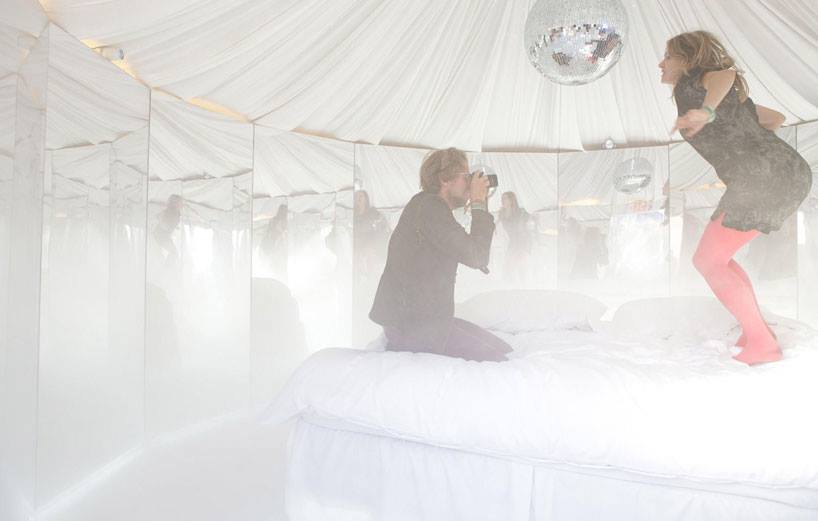
URS FISCHER
Урс Фишер
nomadic art tent
The nomadic sculpture that Urs Fischer created for Station to Station is something of a steamy interior dreamscape, a glittery, shimmering vision that hypnotizes with lights and textures that both welcome and disorient. In the center of the piece is a plush Hasten’s bed on which viewers lie surrounded on all sides by mirrors and cloud-like smoke. A disco ball rotates above. Is this a place for disco naps? Or is it a glamorous fantasy of decadence and visual riches? Spend some time, look at yourself in the many reflective surfaces, and feel the bedding against your skin and decide for yourself. Dreamy as it is, this space is grounded in the real world and governed by the laws of physics. This place seems like a fantasy, but it is entirely real. As one critic noted of an earlier Fischer work:In a world increasingly defined by virtual realities and digital imaging, is the creative mastery of hand manufacture merely a quaint artistic throwback — nostalgia for a lost cultural past? Is this sculpture a memorial? Given today’s ubiquitous special effects wizardry, shouldn’t art clasp technology to its bosom? There’s nothing virtual about the softness of the bed, nothing digital about the gleam of those lights or the mist surrounding you. Take off your shoes. Climb inside. This is real life.


SUZAN DRUMMEN
kaleidoscopic crystal floor
dutch artist suzan drummen’s large-scale floor installations are mesmerizing and complex circular patterns made out of mirrors and brightly colored glass. the fractal-like arrangements feature ornate and elaborate circles growing exponentially out of each other and vibrant rings of spiraling colors winding into the surface of the floor. they are composed of crystals, chromed metal, precious stones, mirrors and optical glass. a sensory experience, and visually stimulating, the glittering installations play with the architecture of the space — climbing up walls and sweeping across the surfaces — examining the idea of illusion and optical effects.



AUJIK
Impermanence Trajectory: the limbic nest.
via highlike submit
Earlier AUJIK referred to this in terms of natural and unrefined computation but after German AI scientist Jurgen Schmidhuber introduced the more comprehensive view of Panacomputationalism it’s been adapted.In this manifestation called ‘Impermanence Trajectory: the limbic nest’, this idea is explained through a sacred rock located at an ancient Yamabushi(4) area called Ishiyama.A rock consist of approximately ten trillion trillion atoms in a kilogram of matter, electrons scattering and bouncing back and forth making it a very vivid space with a vast computational potential.

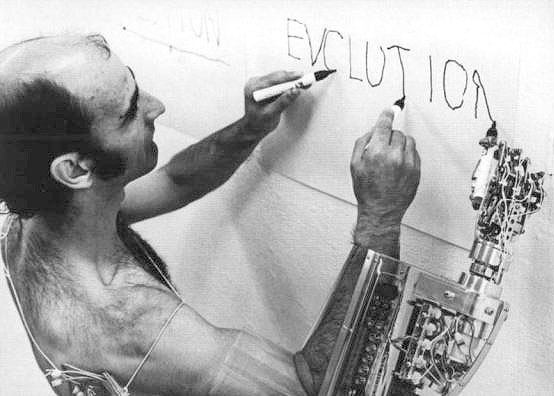
STELARC
drawing with robot arm
“With gene mapping, gender reassignment, prosthetic limbs and neural implants, what a body is and how a body operates becomes problematic. We generate Fractal Flesh and Phantom Flesh, extended operational systems and virtual task environments. Meat and metal mesh into unexpected and alternate anatomical architectures that perform remotely beyond the boundaries of the skin and beyond the local space it inhabits. The monstrous is no longer the alien other. We inhabit an age of Circulating Flesh. Organs are extracted from one body and inserted into other bodies. Limbs that are amputated from a dead body can be reattached and reanimated on a living body. A face from a donor stitched to the skull of the recipient becomes a Third Face. A skin cell from an impotent male can be recoded into a sperm cell. And more interestingly a skin cell from a female body might be recoded into a sperm cell. Turbine hearts circulate blood without pulsing. In the near future you might rest you head on your loved one’s chest. They are warm to the touch, they are breathing, they are certainly alive. But they will have no heartbeat. A cadaver can be preserved forever through plastination whilst simultaneously a comatose body can be sustained indefinitely on a life-support system. Dead bodies need not decompose, near-dead bodies need not die. Most people will no longer die biological deaths. They will die when their life-support systems are switched off. The dead, the near-dead, the not-yet-born and the partially living exist simultaneously. And cryongenically preserved bodies await reanimation at some imagined future. We live in an age of the Cadaver, the Comatose and the Chimera. Liminal spaces proliferate. Engineering organs, stem-cell growing them or by bio-printing will result in an abundence of organs. An excess of organs. Of organs awaiting bodies. Of Organs Without Bodies.” STELARC

STUDIO NENDO
alice climbing wall